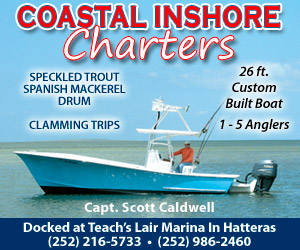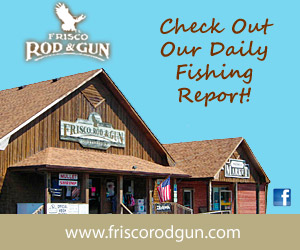If you’re a fishermen, and you’ve been to Rodanthe, then you probably already know Ryan White.
Owner of Hatteras Jack — a store that was started by his dad and grandfather in the 1980s — Ryan has been a fixture on the local fishing scene for more than 20 years and has helped scores of tourists and locals buy, maintain, or customize their reels and rods since 1997.
But recently, Ryan’s ability to alter a fishing rod or reel to work best in local surf-casting conditions has developed into a major operation, and the reels and rods that Ryan once only created for his friends and frequent customers are now propelling him to national attention — in fishing circles, anyways.
The story begins in the late 1980s, when Ryan’s family, who were renting boats and running fishing charters, decided to take advantage of the resurgence in the local striped bass population by transforming their small tackle business into a brick-and-mortar shop.
In between restaurant gigs, Ryan started building his own reels and then selling them in the store, to feed a demand for gear that would work on the tricky Hatteras Island surf fishing landscape.
“It was something people requested, and I knew enough about it to do it, so I started selling them a couple at a time,” says Ryan.
The customizations clearly worked, and Ryan used his own modifications to his advantage. In the early 2000s, he had set the state record for 4-ounce casting and was the state distance champion.
“In making a long-distance fishing reel, friction is the enemy and weight is the enemy,” he explains. “Friction is the enemy because if you want the best distance, you have to have the fastest bearings and least amount of wind drag on the spool that you can get.”
“Weight is enemy because when you have more weight, it takes more to start the spool spinning and takes more breaking to keep it under control once you get it spinning.”
Early on in his customization venture, Ryan was buying kits from the United Kingdom and modifying the existing reels with the specialized equipment. The U.K. is a good resource, because the beaches in the area are massively wide, so achieving distance is essential – much like Hatteras Island.
As his work progressed, he started developing his own kits — and his own style of magnetic braking — and then installing the magnetic braking systems in-house, using factory side plates.
“Once I developed my own system of putting magnetic brakes in fishing reels, I figured out how to adapt that system for almost any conventional fishing reel,” he says. “I was building the mag kits from scratch, and was retro-fitting spool bearings and also drag washers for fishing drags, gear systems, and removing level lines.”
Since he latched onto this process, his work remained steady, and for a decade or so he created roughly 100 custom reels per year for eager customers.
“The business came from word of mouth — I never put a ton of work into advertising,” he says. “Most of my business still comes from social media and word of mouth.”
After a 10-year period or so of building custom reels for islanders, two things happened to launch Ryan into a global operation.
The first was a partnership with Release Reels out of Burgess, Va. Word of mouth about Ryan’s talents had clearly spread, and the company contacted him to do some consulting on their star-mag reel, or SM reel, which was their first jump into star drag conventional reels for casting.
“Wes Seigler, the founder and CEO of Release Reels, stopped into the tackle shop and told me he was interested in building a star-drag casting reel, and he wanted to know if I was interested too,” says Ryan.
After chatting for a while, Ryan jumped on the opportunity.
“Wes and I have a very similar idea of how things should be done. And that is the ‘right way,’” says Ryan. “It’s just being the best that you can possibly be, bar none.”
Of course, doing things the “right way” can take some time.
And Ryan and the Release Reels team spent four years working on the SM, trying to find the best quality raw materials, best components, and using a 3-D printer to see how everything fit together, before finally releasing the reel in the spring of 2015.
It’s been a hit in local circles, but has also been sold all along the coast, in fishing shops in New Jersey, Long Island, Florida, and California.
“Overall the response has been good, and it’s been a huge success,” says Ryan.
But partnering on a custom reel hasn’t been Ryan’s only ambitious venture, and the second thing that got anglers talking was his design, development, and distribution of a custom rod – which, true to his previous experience with surf fishing, began with a company in Great Britain, called Century.
It was a relationship that had started in the early 2000s, when Ryan started importing Century brand rods to modify for tournament casters in the U.S.
“They have held the world distance casting record for close to 20 years,” he says. “They hold all the world surf casting records – 100, 125, 150, 175, 200, and 225 gram casting records – and many with casts over 900 feet.”
After purchasing plenty of rods, and then adding his own customizations for state-side fishing, Ryan approached Century about developing fishing rods for the U.S. market.
Century agreed, and today Ryan White is the U.S. designer, product developer, and distributor for his own line of “Century” rods.
For these rods, the blanks are manufactured in the U.K. and then shipped to custom builders in the United States. “I was building many of the rods in-house in the early days, but was unable to keep up with demand, so had to subcontract the rods out to someone who had a larger capacity,” says Ryan.
The distance that the U.K. rods provided was an excellent start, but modifications had to be made to make them conducive to American fishing.
“U.K. is a barren wasteland of a fishing area,” says Ryan. “Long flat beaches with drastic tidal changes, and waters that have been overfished. So you need very long casting there, and this also works well on the U.S. side, but you don’t always need the 200-plus yard casts.”
“The U.K. rods are 14 feet long with very soft tips,” he adds. “And as an example, the Northeast market requires 9-11 feet for the majority of fishing, throwing a maximum of a 2- to 3-ounce lure, versus 14 feet and throwing 10-12 ounces.”
Because of these discrepancies, changes are made on a grand scale to adapt the nice long-casting rods to work best with regional markets on the East Coast and beyond.
And the reception has been huge.
Ryan’s Century rods have been garnering a following all across the coast, especially in the Northeast and New England states where Ryan attends a number of national fishing shows to show off the goods.
Currently two thirds of the rods are factory made, and a third are custom, and Ryan is still adapting the Century rods to appeal and cater to different markets.
“The next thing I’m working on is the West Coast market,” says Ryan. “I’m planning on staying based in N.C., but getting to spend a good bit of time on the West Coast. I’m also looking at Central and South American markets on the international side, which are both emerging markets.”
And while folks who are used to seeing Ryan at Hatteras Jack in Rodanthe might not run into him as much – he travels roughly 90 percent of the time now, from Florida to Texas to New York – dedicated anglers will be pleased to know that even though Ryan effectively has two national operations in place, his days of customizing and creating new rods and reels are far from over.
“Oh I’m going to keep customizing and honing the design,” says the long-distance champ. “And while you don’t always need distance, it’s just the human need to go longer, further, and conquer more.”
FOR MORE INFORMATION
Hatteras Jack’s website is http://www.hatterasjack.com/index.htm.





